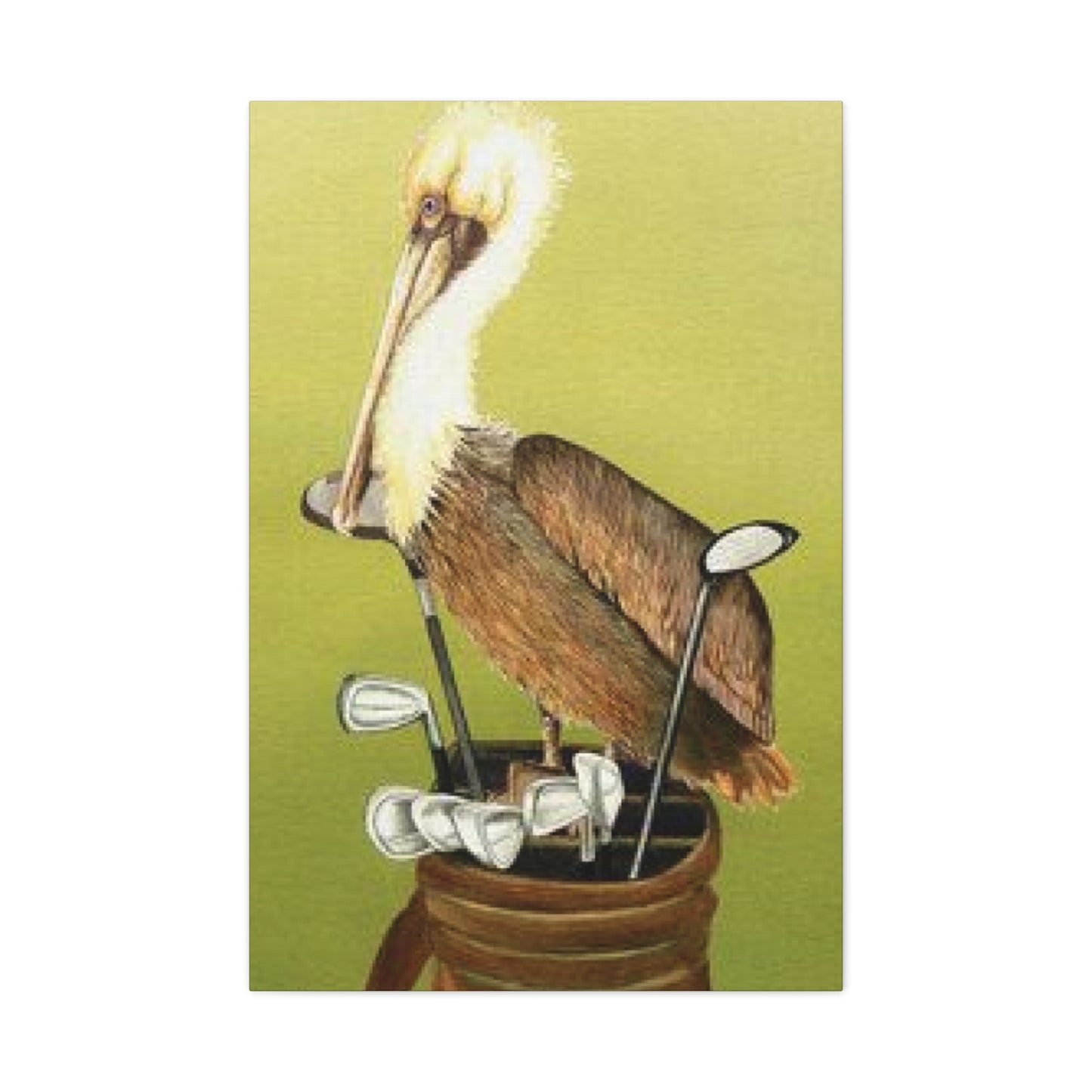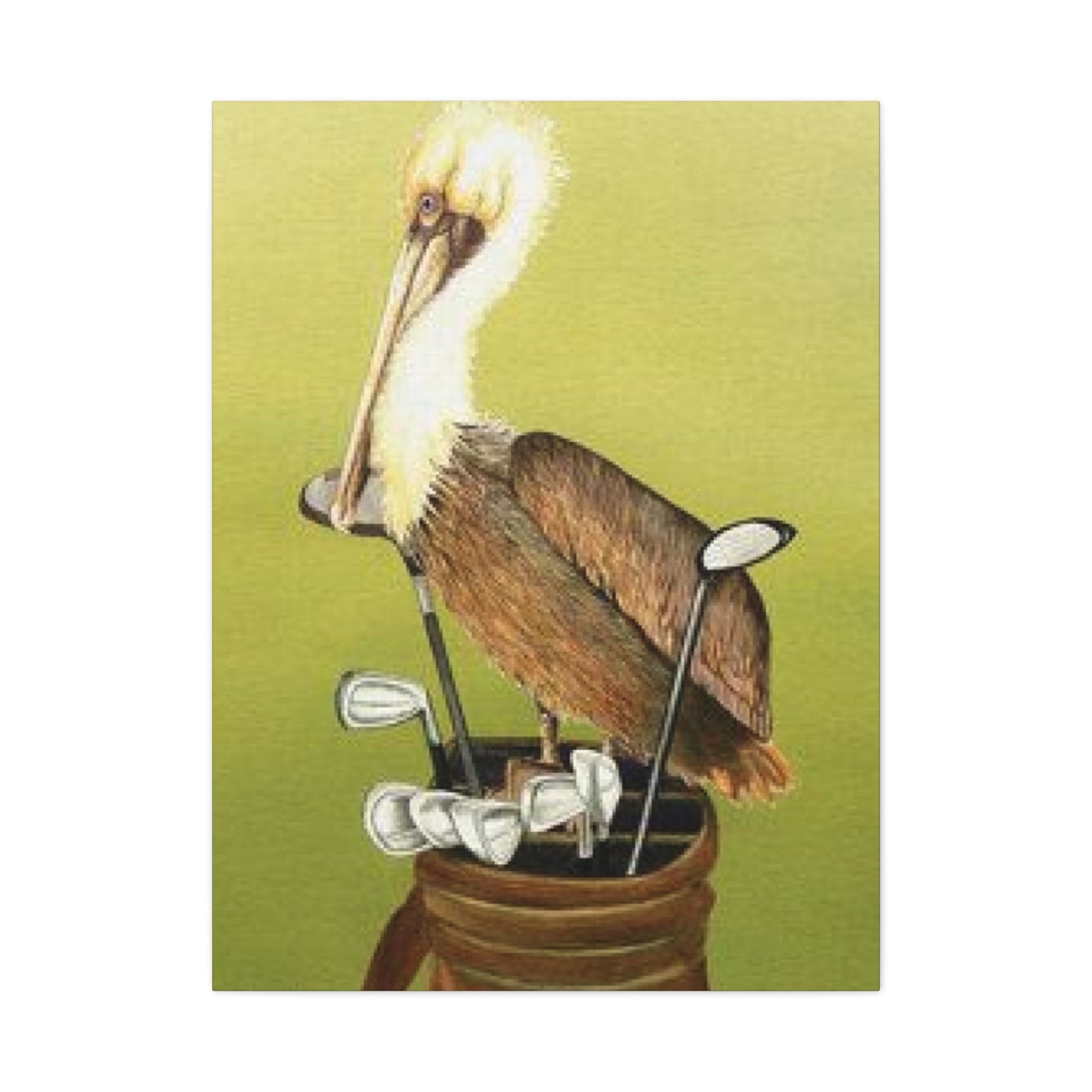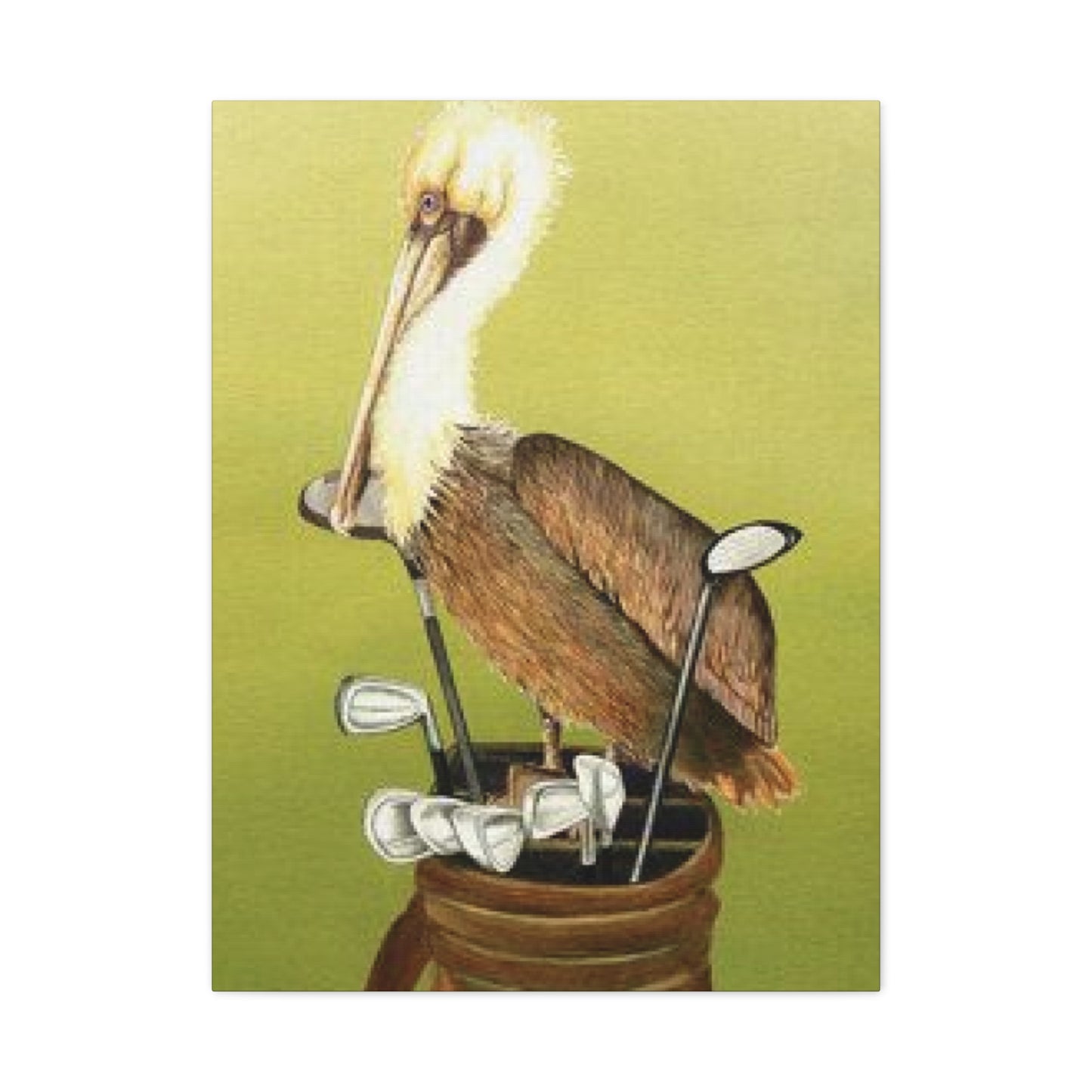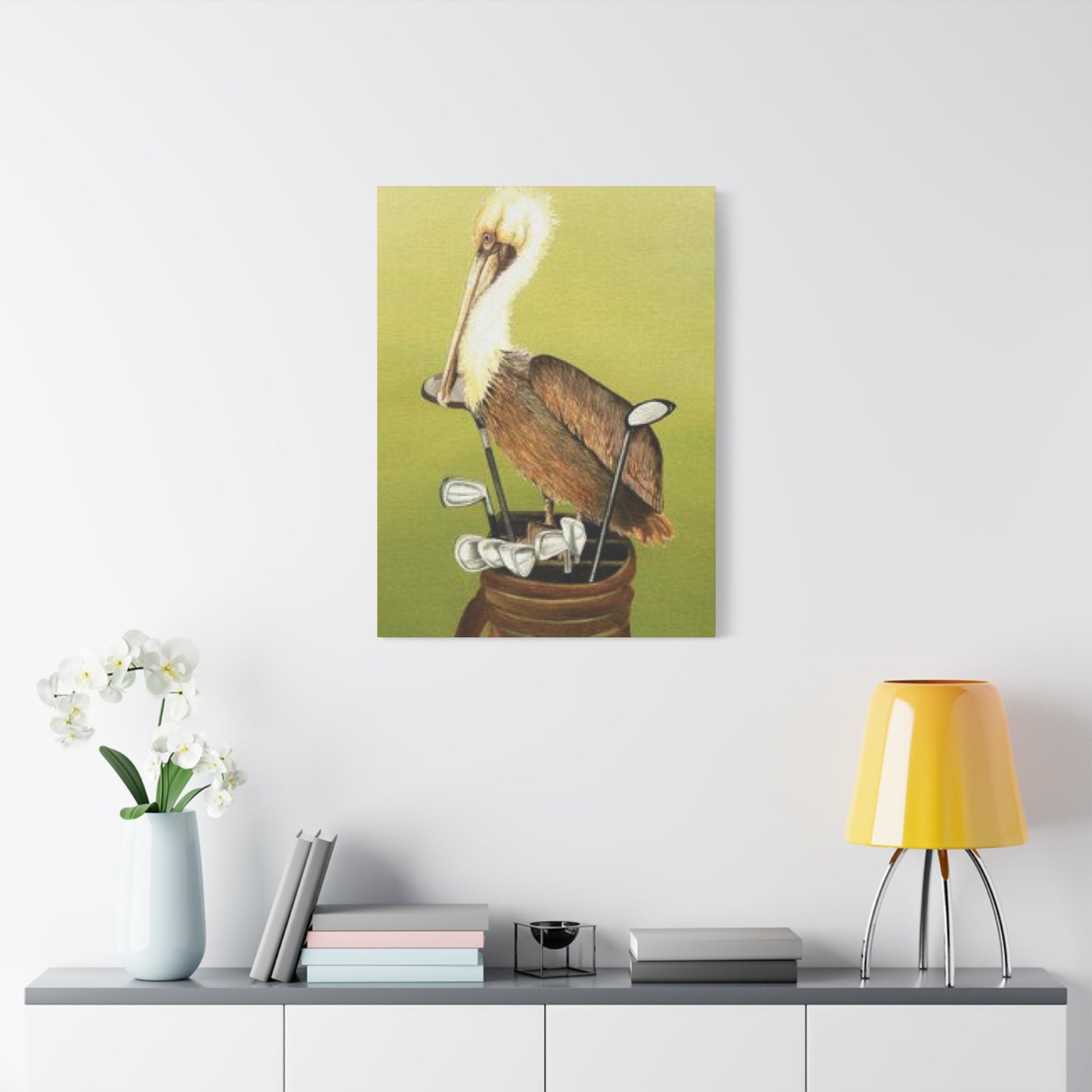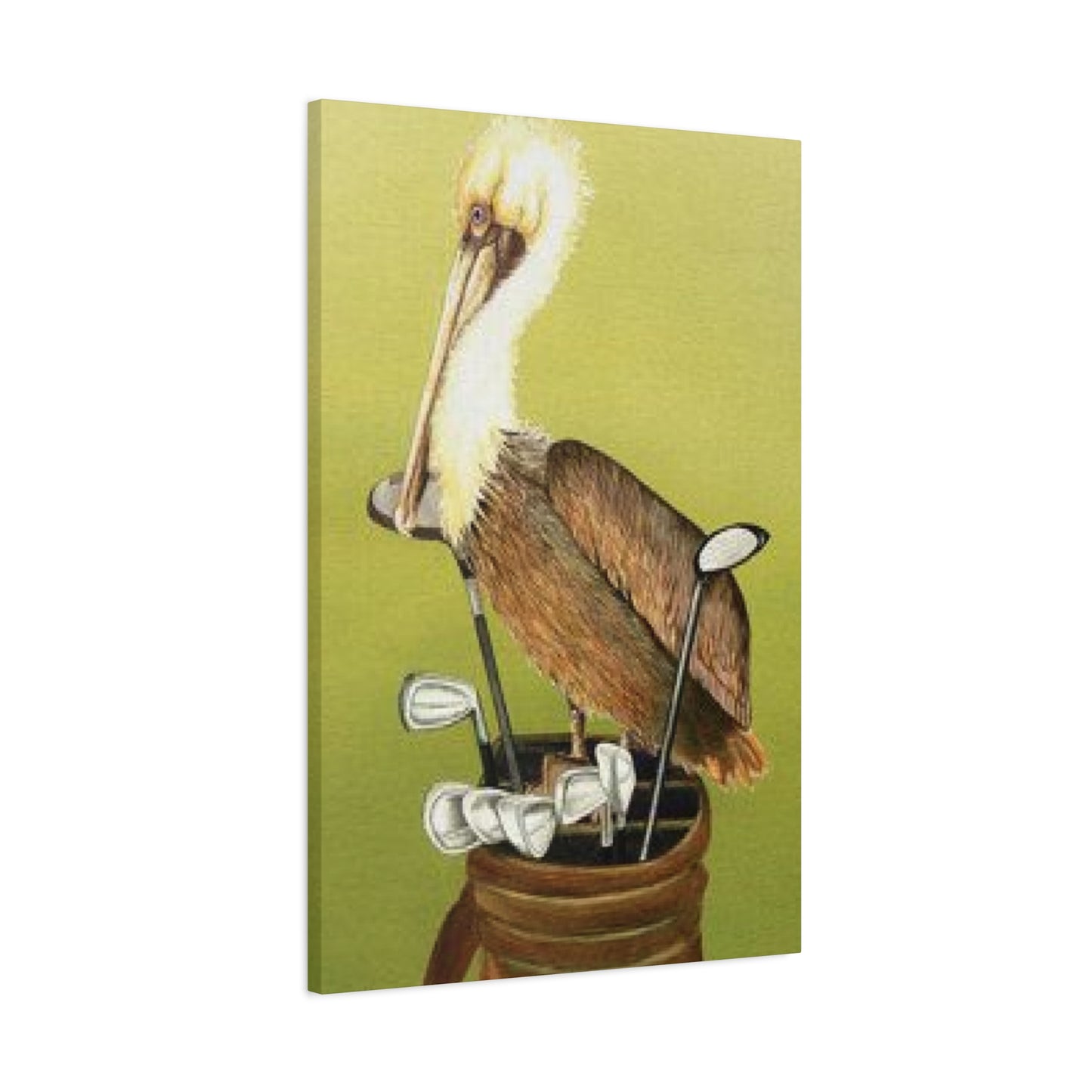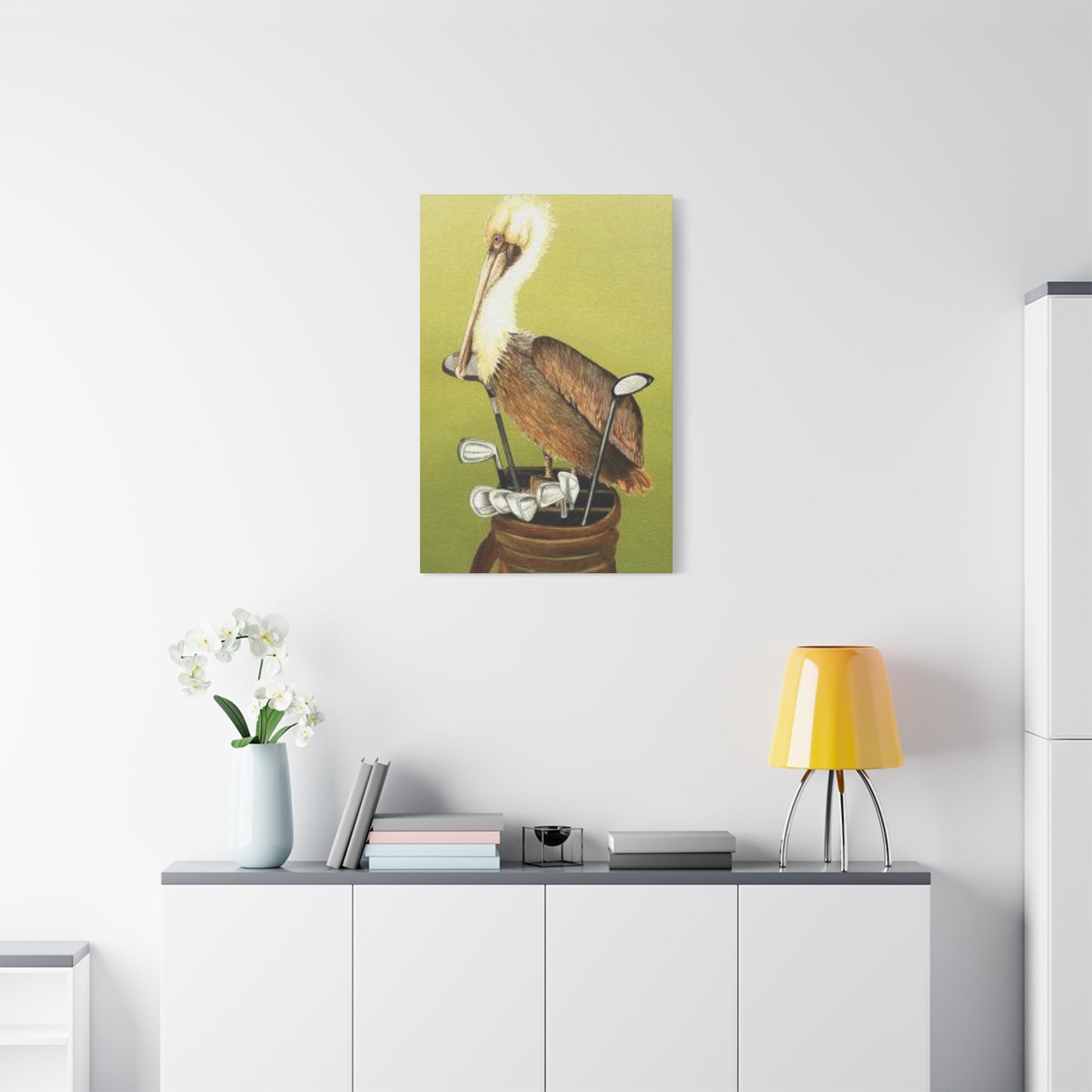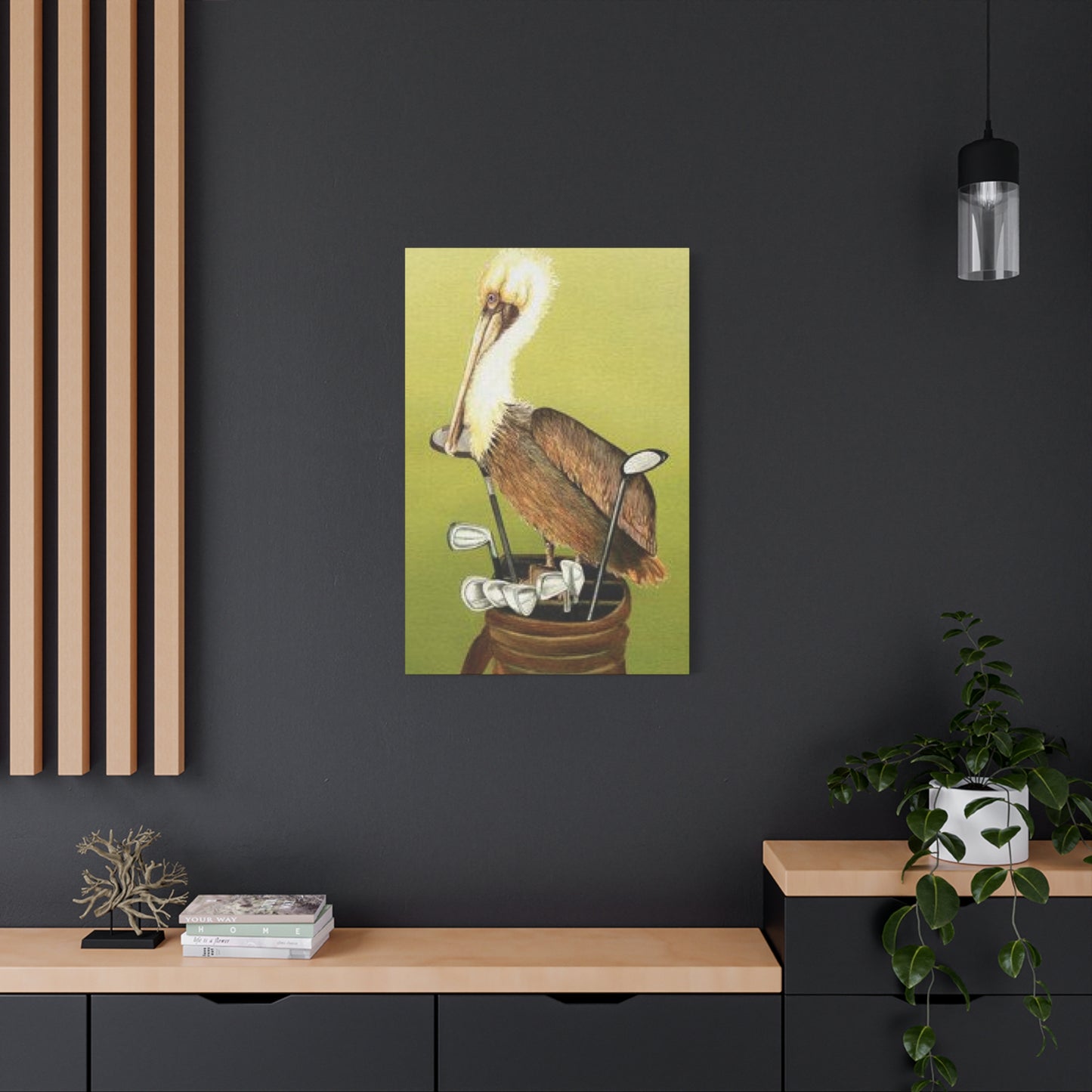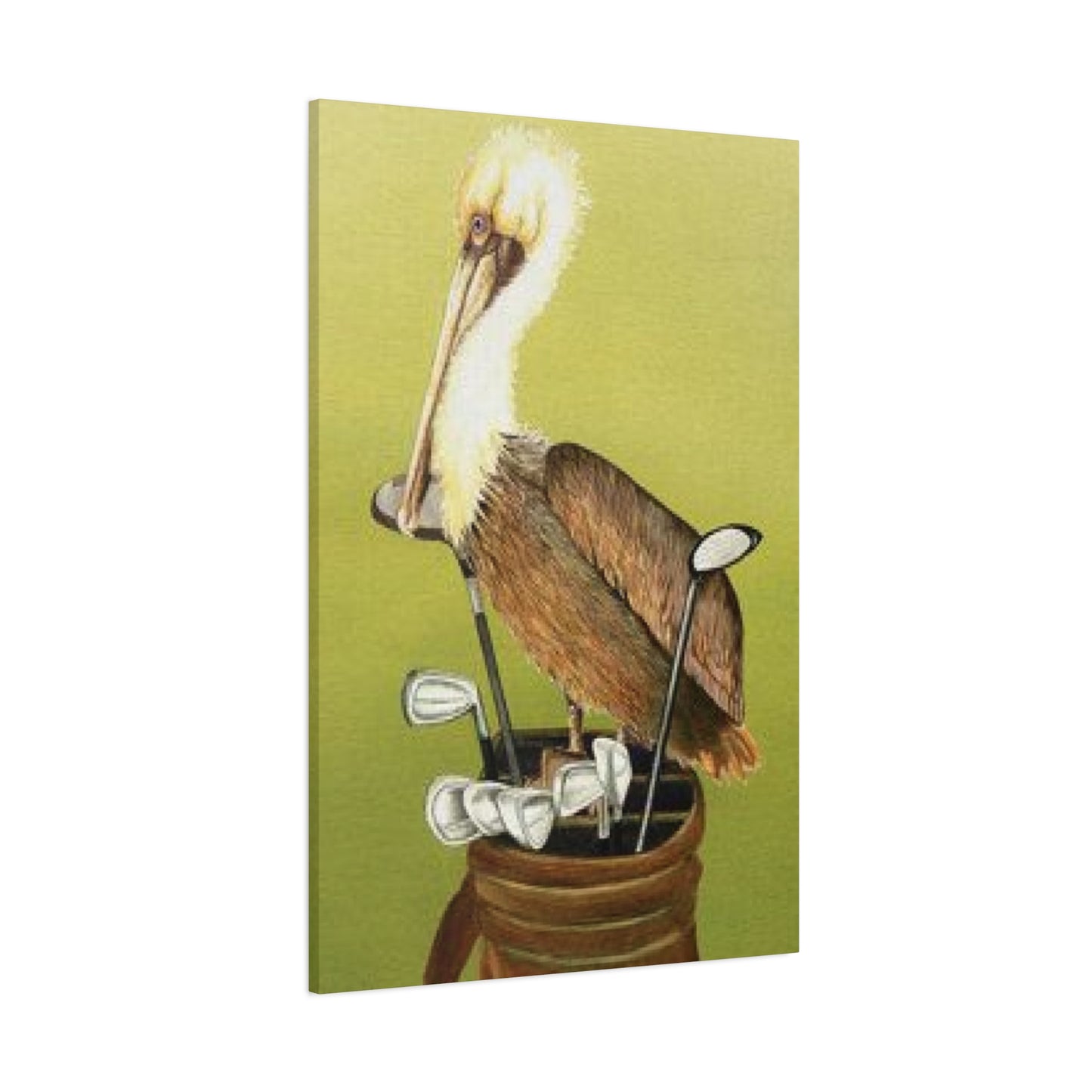Classic Wildlife to Playful Sport: Exploring the Fusion in Pelican Golf Bag Painting Wall art
The intersection of natural wildlife imagery and golf culture has created an entirely new niche within the contemporary art market. Over the past two decades, the demand for distinctive wall art featuring pelicans and golf-related themes has significantly expanded among collectors and interior designers worldwide. This artistic movement represents a fusion of outdoor recreation enthusiasm with appreciation for wildlife aesthetics, creating pieces that resonate with both sports enthusiasts and nature lovers. The popularity of pelican-themed golf bag canvas paintings reflects a broader cultural shift toward personalized home environments that celebrate individual interests and passions.
When homeowners select wall art depicting pelicans positioned near or with golf equipment, they are making a statement about their lifestyle and values, whether that involves actual golf participation or simply an appreciation for coastal imagery. The versatility of canvas prints as a medium has democratized access to quality artwork, allowing individuals from various economic backgrounds to invest in meaningful decor that transforms their living and working spaces. Pelican motifs specifically carry rich symbolic meaning in Western culture, often representing grace, stability, and abundance while simultaneously evoking feelings of relaxation and vacation vibes. When combined with golf accessories like bags, clubs, or course elements, these artistic pieces create layered visual narratives that appeal to a sophisticated demographic seeking distinctive decor solutions.
Why Pelicans Resonate with Golf and Coastal Lifestyle Aesthetics
Pelicans hold a special place in the hearts of those who love golf, particularly among enthusiasts who play courses in coastal regions or tropical destinations. These magnificent birds possess inherent qualities that align perfectly with the golfing experience: patience, precision, and an unhurried approach to life. The pelican's distinctive silhouette, with its characteristic pouch and long bill, makes for instantly recognizable and visually striking artistic subjects. In golf culture, pelicans represent not only the coastal settings where many world-renowned courses are located but also the serene, contemplative nature of the sport itself. Golfing is fundamentally about patience, strategy, and enjoying time spent in natural environments, values that pelicans embody through their hunting techniques and habitat preferences. The connection runs deeper than mere aesthetic appeal; it represents a philosophical alignment between the sport of golf and the natural world.
Many prestigious golf courses, particularly in Florida, South Carolina, and other coastal American regions, feature pelican populations prominently in their landscapes. Players frequently encounter these birds during their rounds, creating memorable associations between their golfing experiences and pelican sightings. This emotional connection translates into strong demand for artwork that captures these moments and memories. Artists who incorporate pelicans into golf-themed compositions understand this psychological connection and leverage it to create pieces that resonate on multiple levels with their audience. The color palettes associated with pelicans, ranging from whites and grays to subtle blues and browns, complement golf course environments perfectly, creating harmonious visual compositions that feel authentic and organic. When displayed in homes or offices, pelican and golf bag artwork serves as a daily reminder of peaceful moments spent pursuing a beloved activity outdoors.
Artistic Styles and Composition Techniques in Pelican Golf Artwork
The creation of compelling pelican and golf bag artwork involves careful consideration of artistic principles including composition, color theory, perspective, and subject matter hierarchy. Different artistic styles produce dramatically different effects, appealing to various aesthetic preferences and interior design schemes. Realistic or photorealistic styles aim to capture every detail with precision, resulting in artwork that appears almost photographlike in quality. This approach appeals to those who appreciate technical skill and faithful representation of subject matter. Photorealistic pelican and golf paintings require artists to study their subjects extensively, understanding anatomical structures, lighting conditions, and environmental details that create convincing representations.
The advantage of this style lies in its immediate visual appeal and accessibility to viewers from all backgrounds, as realistic imagery requires no interpretive framework to appreciate. Conversely, abstract or semi-abstract interpretations of pelicans and golf themes prioritize emotional expression and innovative visual representation over faithful replication. These pieces often employ bold color choices, simplified forms, and expressive brushwork that encourage viewers to engage in personal interpretation. Abstract styles create striking visual statements that become focal points in contemporary interior design schemes, particularly in modern and minimalist spaces. Contemporary watercolor approaches to pelican and golf themes offer another compelling option, combining loose brushwork with fluid color transitions that suggest rather than delineate details.
Watercolor paintings scanned and reproduced as canvas prints convey a sense of spontaneity and artistic expression that appeals to those seeking more personal, handcrafted aesthetic qualities. Digital art and illustration styles represent another significant category, wherein artists use computer technology to create clean, polished artwork with precise control over every element. These digitally created pieces often feature distinctive stylization, vibrant color palettes, and creative compositions impossible to achieve through traditional media. Collage-based approaches, combining photographic elements with artistic additions, create unique hybrid styles that blur boundaries between photography and painting. Each artistic approach brings its own strengths and appeals to different segments of the collector market.
Design Elements That Enhance Golf and Pelican Artwork Appeal
The successful integration of pelican imagery with golf-related elements requires thoughtful design choices that create visual coherence and balanced composition. When artists position pelicans in relation to golf bags, clubs, or course settings, they must carefully consider how these different elements interact within the overall composition. Placement strategies significantly influence how viewers process and appreciate the artwork. Positioning the pelican as the primary subject with golf elements in the background creates emphasis on the natural beauty of the bird while maintaining the golf connection. Alternatively, integrating the pelican and golf elements equally throughout the composition creates a more unified blend of themes that appeals to those equally passionate about both subjects.
Color coordination between the pelican and surrounding golf elements helps create visual harmony within the piece. Many golf bags feature specific color schemes, brand colors, or traditional golf palette elements such as greens, whites, and earth tones. Selecting color palettes that complement these elements creates artwork that appears intentionally designed rather than accidentally coincidental. The incorporation of environmental elements such as coastal settings, golf courses, water features, or sunset skies adds depth and context to the artwork. A pelican positioned against a dramatic sunset, standing near a golf bag against the backdrop of a visible fairway or bunker, creates a narrative that elevates the piece beyond simple subject matter combination.
Lighting effects dramatically influence the mood and visual impact of pelican and golf artwork. Soft, diffused lighting creates peaceful, contemplative moods suited to residential spaces, while dramatic lighting with strong shadows and highlights creates more dynamic, energetic compositions suited to commercial or office environments. The inclusion of fine details such as water droplets on the pelican's feathers, worn leather on golf bags, or specific architectural features of familiar golf courses adds layers of visual interest that reward sustained viewing. Negative space, the unoccupied area surrounding main subjects, plays an essential role in composition. Artwork with generous negative space creates a sense of openness and calm, while densely composed pieces with minimal negative space convey energy and visual complexity.
Creating Personalized Spaces with Custom Pelican Golf Art
The contemporary art market increasingly offers custom creation options that allow individuals to commission artwork specifically tailored to personal preferences, existing decor, or specific spaces. Custom pelican and golf-themed artwork represents the ultimate personalization opportunity, enabling collectors to own truly unique pieces that reflect their individual personalities and interests. Custom commissions begin with consultation processes wherein artists discuss client preferences, existing decor, personal stories, and artistic visions. Detailed conversations about color preferences, size requirements, artistic style preferences, and specific thematic elements ensure that final pieces align perfectly with client expectations. Many artists provide preliminary sketches or digital mock-ups that clients review and provide feedback on, allowing for refinements before final artwork creation.
This collaborative process often results in pieces that exceed client expectations by incorporating suggestions that artists implement with their professional expertise. Custom artwork pricing reflects the investment of professional artist time, custom material selection, and individualized creation processes. While custom pieces typically cost more than mass-produced prints, the uniqueness, personal significance, and superior quality justify the investment for collectors seeking truly distinctive artwork. Some collectors commission artists to incorporate personal elements into pelican and golf artwork, such as specific golf course layouts, beloved pets alongside pelicans, or family members engaged in golfing activities. These deeply personal artworks become meaningful heirlooms that celebrate family histories and shared experiences. Digital artists specializing in custom work can create complex compositions combining multiple photographs, artistic elements, and thematic components into unified compositions.
The flexibility of digital creation allows artists to experiment with color variations, compositions, and styles before settling on final versions. Traditional artists working in watercolor, acrylic, or oil create custom pieces that showcase individual artistic styles and hand-crafted qualities that digital reproductions cannot fully capture. The visible brushwork and tactile qualities of traditionally created artwork add layers of artistry and authenticity. Limited edition prints, wherein artists create custom paintings and produce limited quantities of canvas prints, offer a middle ground between mass production and completely unique commissions. These limited runs maintain exclusivity while offering more affordable price points than fully custom work. Some artists allow collectors to commission custom artwork and then produce multiple canvas print editions, allowing collectors to share artwork with friends, family, or charity organizations while maintaining a degree of exclusivity through limited production runs.
Gift-Giving Guide for Golf Enthusiasts and Wildlife Art Lovers
Selecting appropriate gifts for individuals passionate about golf, wildlife, and artistic expression requires understanding how these interests intersect and how pelican golf-themed artwork serves unique gift purposes. Pelican and golf-themed canvas prints represent versatile gift options suitable for multiple occasions including birthdays, housewarming celebrations, retirement parties, and achievement recognitions. The personal nature of artwork celebrating specific interests makes these pieces feel thoughtful and individualized compared to generic gift alternatives. For golfers and golf course enthusiasts, pelican artwork combined with golf elements celebrates their passion through artistic expression. Pieces featuring specific well-known courses or signature pelican poses create conversation pieces and memory anchors for golfing experiences.
For individuals relocating to coastal communities or golf destinations, pelican and golf-themed artwork helps personalize new living spaces and smooths transitions into unfamiliar environments. Artwork celebrating the culture and natural features of new locations provides immediate environmental connections. For office settings and professional environments, golf and pelican-themed artwork projects confidence, leisure sophistication, and refined aesthetic taste. Professional offices benefit from artwork that creates welcoming environments and reflects occupants' personalities without appearing frivolous or overly casual. For home offices and personal workspaces, pelican and golf-themed artwork provides motivational visual elements and stress-reducing natural imagery that support productivity and focus.
Home office workers benefit substantially from biophilic design elements incorporating nature and outdoor imagery. For retirement gifts celebrating transitions from active careers to leisure-focused lifestyles, pelican and golf-themed artwork acknowledges recipients' anticipated activities and interest transitions. Such artwork celebrates earned relaxation and life stage transitions appropriately. For wall space above existing golf memorabilia or sporting equipment, coordinated artwork creates cohesive displays that showcase collections effectively. Artwork complementing existing collections without duplicating themes creates balanced presentations. For collectors of specific artist work, commissioning pelican and golf-themed pieces allows friends and family to contribute to established collections meaningfully. Custom commissions ensure artistic continuity and personal relevance.
For individuals with limited display space or rental situations where permanent wall installations prove impossible, smaller canvas prints or gallery-wrapped versions on portable easels provide flexible display options. Gift recipients appreciate options accommodating their specific living situations and constraints. Price points for pelican and golf-themed canvas prints accommodate various budgets, from modest prints suitable for modest gift budgets to substantial investments for significant milestone celebrations. Gift-givers can select pieces matching their financial situations while maintaining perceived thoughtfulness and quality. Personalization options including custom sizing, color adjustments, or inscription additions transform standard artwork into deeply meaningful gifts. Recipients appreciate the additional effort required for personalized gifts.
Marketing and Commercial Applications for Golf and Pelican-Themed Artwork
Beyond personal enjoyment and home decoration, pelican and golf-themed artwork serves significant commercial purposes in hospitality, retail, and corporate environments. Golf clubs and courses increasingly incorporate thoughtfully selected artwork into clubhouses, dining areas, and member lounges. Pelican imagery particularly resonates in coastal courses where members encounter these birds during play. Professional art curation within these spaces elevates member experiences and reinforces the prestige and refined aesthetic characterizing the facilities. Artwork celebrating the specific course, local wildlife, and golfing culture creates distinctive environments that differentiate premium facilities from competitors. Hotels and resorts catering to golf tourists benefit substantially from strategic artwork placement creating immersive environments celebrating golf culture and local natural heritage.
Pelican and golf-themed pieces in lobbies, hallways, and guest rooms extend thematic consistency throughout properties. This environmental reinforcement supports brand identity and guest satisfaction by creating cohesive, intentionally designed experiences. Restaurants and bars frequented by golf enthusiasts welcome golf and pelican-themed artwork that creates welcoming environments celebrating shared interests. Sports bars adjacent to golf courses naturally incorporate golf-related artwork into overall design schemes. Fine dining establishments in golf-centric communities use sophisticated golf and wildlife artwork to elevate dining ambiance. Corporate offices of golf equipment manufacturers, golf publications, and golf industry businesses integrate brand-aligned artwork into office environments.
Pelican and golf themes reinforce company identity and create work environments reflecting industry focus. Pharmaceutical offices, legal firms, and non-golf companies with golfer clients or employees appreciate golf-themed artwork creating welcoming environments for valued clients and staff. Golf equipment retail locations benefit from strategic artwork placement featuring actual products within artistic contexts. Seeing clubs, bags, and accessories within appealing artistic compositions enhances perceived value and encourages purchasing impulses. Showroom displays incorporating artwork alongside product displays create sophisticated retail environments that support premium pricing. Pro shops at golf courses incorporate pelican and golf-themed artwork creating distinctive retail experiences matching course ambiance.
Interior design companies specializing in hospitality, corporate, or residential design incorporate pelican and golf artwork into comprehensive design schemes. These professionals understand principles of color coordination, spatial planning, and thematic consistency that elevate overall design impact. Corporate art consulting services advise businesses on strategic artwork selection supporting brand identity, employee wellness, and client impressions. These consultants often recommend golf and wildlife-themed pieces for golf-centric companies or companies seeking to project refined, established reputations. Commercial photography for golf and sports publications increasingly incorporates canvas art and decorated environments as backgrounds. Professional photographers recognize aesthetic contributions that well-selected artwork provides to overall visual compositions.
Digital Reproduction Print Quality Standards
Modern digital technologies have revolutionized how artists create original artwork and how those creations are reproduced as canvas prints. Understanding technical specifications and quality standards helps consumers select superior products offering optimal visual and longevity performance. Digital scanning of original artwork, whether paintings, photographs, or mixed media, requires professional-grade equipment capturing precise color information and fine detail. High-resolution scanning produces digital files containing millions of pixels ensuring that reproductions accurately represent original artworks. Scanner specifications including bit-depth, dynamic range, and color accuracy profiles directly influence final reproduction fidelity. Professional archival scanning services produce superior results compared to consumer-grade scanning equipment.
Digital color correction processes bring scanned images into conformance with original artwork appearance while compensating for scanner limitations and environmental factors affecting capture processes. Professional color correctors understand color theory and digital imaging principles, making sophisticated adjustments ensuring faithful reproduction. Digital image enhancement processes increase contrast, adjust saturation, and optimize images for canvas print reproduction without altering fundamental artistic integrity. These enhancements compensate for the inherent differences between viewing original artwork and viewing canvas reproductions. High-resolution digital files, typically containing forty million to one hundred million pixels, ensure that enlarged prints maintain sharpness and detail fidelity even in extra-large formats.
Lower resolution files produce visible pixelation and blurriness in enlarged prints, compromising visual quality. Archival digital storage ensures that master files from which prints are produced remain uncorrupted and available for years, supporting reproduction consistency and long-term availability. Backup systems and redundant storage protect against data loss from equipment failures or disasters. High-end inkjet printers utilizing twelve or more color channels produce photographic quality prints with smooth tonal gradations and superior color accuracy. Traditional four-color printing processes, while economical, produce less sophisticated color reproductions. Advanced ICC color profiles ensure that digital files print with color accuracy matching original artwork and client expectations.
These technical standards maintain consistency across multiple print runs ensuring that replacement prints or additional copies match original prints precisely. Printing on premium canvas stocks produces superior results compared to lower-quality canvas substrates. Canvas composition, weave density, and surface finishes directly influence how inks adhere and how finished prints appear. Matte canvas finishes reduce glare and create classic artwork appearance, while semi-gloss or gloss finishes enhance color vibrancy and create more contemporary aesthetics. Layered finishes including varnish top coats protect prints from dust, humidity, and environmental contaminants while adding surface interest and depth. UV-protective varnishes prevent color fading from sun exposure, dramatically extending the lifespan of canvas prints intended for brightly lit spaces.
Caring for Canvas Prints and Maintaining Long-Term Visual Appeal
Proper care and maintenance ensure that pelican and golf-themed canvas prints retain visual appeal and structural integrity throughout their lifespans. Understanding optimal environmental conditions and appropriate cleaning techniques prevents damage and extends artwork longevity. Temperature and humidity stability prove essential for canvas print preservation. Extreme temperature fluctuations cause canvas expansion and contraction, potentially stressing stretcher bars and frame joints. Humidity variations create similar stress conditions and can encourage mold or mildew growth on canvas surfaces. Maintaining consistent temperatures between sixty and seventy-five degrees Fahrenheit and humidity levels between thirty and fifty percent provides optimal conditions. Moderate light exposure supports artwork enjoyment without accelerating color fading.
Direct sunlight, particularly intense afternoon sun, causes color degradation in both traditional inks and modern archival formulations. Window coverings including sheer curtains or light filtering blinds protect artwork from direct sun while allowing ambient light enjoyment. Rotating artwork periodically distributes light exposure across canvas surfaces, promoting even aging and preventing localized fading. Avoid positioning canvas prints directly above heat sources including radiators, fireplaces, or forced-air heating vents. Heat exposure accelerates canvas degradation and ink fading, dramatically reducing artwork lifespan. Similarly, position artwork away from cold sources including exterior walls in cold climates, uninsulated windows, or air conditioning vents. Moisture accumulation behind canvas or condensation on canvas surfaces encourages mold growth and image degradation. Ensure adequate air circulation around artwork by maintaining several inches of clearance between canvas edges and walls.
Gentle dusting removes accumulated dust without damaging canvas or inks. Use soft brushes, lint-free cloths, or specialized static dusting tools to gently sweep dust from canvas surfaces. Avoid direct contact between dust cloths and canvas surfaces, as friction can damage ink layers. For stubborn dust or environmental contaminants, professional art conservators employ sophisticated techniques ensuring safe removal without damage. Avoid using water, cleaning solutions, or commercial cleaning products on canvas prints. Moisture infiltration can damage inks, promote mold growth, and compromise structural integrity. Professional conservation services utilize specialized techniques and products appropriate for canvas print care.
Inspect canvas stretchers and frame joints periodically for signs of separation, warping, or damage. Wood stretchers can warp slightly from humidity variations, potentially affecting how stretched canvas sits flat against walls. Re-stretching by professionals restores flatness and ensures proper presentation if stretchers become compromised. Frame glass or protective coverings prevent direct contact with canvas while allowing artwork enjoyment. Plexiglass or polycarbonate materials provide safety benefits and reduce harmful light penetration compared to traditional glass. UV-protective glazing options provide enhanced protection from fading without significantly altering artwork appearance. Secure wall mounting ensures artwork remains stable and unlikely to fall or shift position.
Comparing Canvas Prints to Alternative Wall Decor Options
While canvas prints represent compelling wall art options, other alternatives serve similar purposes with different advantages and disadvantages. Understanding how canvas prints compare to alternative options helps consumers make informed choices matching specific needs and preferences. Traditional framed prints or posters offer economical entry points into art collection for budget-conscious consumers. Frame and mat combinations allow customization matching existing decor schemes. However, framed prints generally appear less substantial than canvas prints and lack the museum-quality aesthetic associated with wrapped canvas presentations. Framed prints require additional wall space for frame perimeters, potentially appearing less visually integrated into overall space designs.
Wooden artwork and carved pieces provide dimensional quality and tactile interest that flat canvas prints cannot achieve. Hand-carved or sculpted pelican and golf representations create striking focal points and genuine artistic craftsmanship. However, carved artwork typically requires more extensive wall space, costs substantially more than canvas prints, and demands more careful installation procedures. Painted wall murals provide dramatic impact and complete environmental immersion impossible with portable artwork. Custom murals allow unlimited creative expression and integrate artwork seamlessly into specific spaces. However, murals require professional execution, cost significantly more than canvas prints, and cannot be relocated or replaced easily if aesthetic preferences change.
Photography prints on various substrates including metal, aluminum, or paper provide alternatives to canvas. Metal prints offer contemporary aesthetics and enhanced durability in humid environments. However, metal prints typically cost more than equivalent canvas prints and require different hanging hardware. Wallpaper incorporating artistic designs creates comprehensive environmental coverage. Wallpaper allows for dramatic visual transformations of entire spaces with cohesive patterns. Peel-and-stick wallpaper options provide temporary solutions for renters or those preferring non-permanent installations. However, wallpaper removal can damage walls, and large-scale pattern repetition may appear monotonous compared to individual canvas print displays.
Textile wall hangings including tapestries and fabric art provide soft textures and traditional artisan qualities. These pieces create acoustic benefits while adding visual interest to bare walls. However, textiles require regular cleaning, attract dust more readily than smooth canvas surfaces, and demand careful handling to prevent deterioration. Neon signs and LED light fixtures offer contemporary alternatives creating dynamic visual statements. Golf and sports-themed neon artwork projects modern sophistication and energy. However, these options consume electricity, generate heat, can appear overly trendy, and require careful placement avoiding glare and brightness interference. Three-dimensional shadow boxes containing objects, memorabilia, or artistic compositions create layered visual depth and display capabilities for collectibles. These framed presentations tell complex stories through object combinations.
However, shadow boxes require significant wall space, prove expensive, and demand skillful arrangement to achieve aesthetic appeal. Mirrors, often overlooked as wall art alternatives, provide functional benefits while creating visual space expansion and light reflection. Decorative mirrors with artistic frames contribute to design schemes while serving practical purposes. However, mirrors cannot display imagery or subject matter like artwork, limiting their storytelling capabilities. Vinyl decals and sticker-based wall art offer economical temporary options particularly suited to rental situations or trial periods before permanent installations. These options provide quick transformations without wall damage. However, decals lack the visual sophistication and artistic depth of canvas prints, and removal often leaves residue or damage.
Floating shelves displaying sculptures, pottery, or collectibles create curated displays combining functional storage with decorative presentation. These arrangements showcase personal collections and interests dynamically. However, shelves require wall space and structural support, demand regular organization and dusting, and work best in homes with substantial collections justifying display efforts. Canvas prints compare favorably to most alternatives through their balance of affordability, visual impact, ease of installation, and lasting appeal. The versatility of canvas printing technology accommodates virtually any subject matter, artistic style, or size requirement. Gallery-wrapped canvas eliminating visible hardware creates seamless, contemporary appearances. Canvas prints require minimal ongoing maintenance compared to textiles, carved pieces, or decorative object displays.
Exploring Regional Golf Culture and Pelican Symbolism Across Different Coastal Communities
The relationship between pelicans, golf, and regional identity varies significantly across different coastal communities worldwide. Understanding these regional nuances enriches appreciation for pelican and golf-themed artwork and reveals how cultural factors influence artistic preferences and interpretations. In Florida, where pelicans represent state identity and numerous championship golf courses flourish, the combination holds particularly strong cultural resonance. Florida's brown pelican population, once endangered but successfully restored through conservation efforts, carries symbolic significance representing environmental stewardship and resilience. Many world-famous Florida golf courses including The Players Championship and courses throughout the Golf Coast feature pelican sightings as integral components of the golfing experience.
Canvas artwork celebrating this regional identity attracts both residents and visitors with emotional connections to Florida's unique combination of natural heritage and sporting culture. South Carolina's coastal regions similarly embrace pelican and golf themes through established communities like Hilton Head Island and Charleston. These prestigious golfing destinations have cultivated sophisticated cultures celebrating the combination of sporting excellence and natural beauty. Pelican artwork in these communities serves as cultural touchstone acknowledging shared values and aesthetic preferences. California's coastal golf courses present pelican imagery in different contexts, often incorporating Pacific Ocean environments and dramatic landscapes distinct from Atlantic and Gulf Coast settings.
Western pelican species create different aesthetic elements than their eastern cousins, offering fresh artistic possibilities. The laid-back California golf culture, distinct from more formal traditions elsewhere, influences how pelican and golf artwork functions within regional contexts. Texas coastal communities and Gulf Coast regions appreciate pelican and golf combinations representing regional pride and coastal identity. The entrepreneurial spirit characterizing Texas culture influences artwork preferences toward bold, confident compositions celebrating achievement and outdoor adventure. North Carolina's Outer Banks and coastal golf communities have developed distinctive pelican and golf traditions emphasizing natural beauty and environmental preservation.
These regions' strong conservation movements influence artwork selections emphasizing pelican protection and sustainable practices. International coastal golf destinations including Scotland, Ireland, and Australia possess distinct pelican and golf traditions reflecting regional wildlife and golfing cultures. Scottish links courses, set among dramatic coastal landscapes, inspire artwork celebrating the wild beauty of coastal golfing environments. Irish golf culture, emphasizing tradition and natural landscape appreciation, welcomes pelican and golf artwork reflecting Celtic influences and maritime heritage. Australian coastal courses feature unique wildlife including sea eagles and cormorants alongside occasional pelican species, creating regional variations on pelican and golf themes.
Caribbean golf destinations, where tourism and leisure culture dominate, embrace pelican and golf artwork as essential components of resort and hospitality environments. Tropical color palettes and island settings distinguish Caribbean-inspired pelican and golf artwork from temperate region interpretations. Mexico's Pacific and Caribbean coastal courses similarly embrace regional variations incorporating local wildlife species and tropical aesthetics. Central American countries with developing golf industries increasingly commission pelican and golf artwork supporting tourism industry growth. Understanding these regional variations helps collectors select artwork reflecting specific geographic connections or representing areas they love. Commissioning artists familiar with particular regional characteristics ensures authentic representation of specific communities and their unique characteristics.
Seasonal and Thematic Decorating Incorporating Pelican and Golf Artwork
Strategic incorporation of pelican and golf-themed artwork within seasonal and thematic decorating schemes creates dynamic environments reflecting current interests and seasonal changes. While quality artwork remains timeless, thoughtful arrangement and supporting decor create fresh, contemporary feeling throughout the year. Summer seasonal decorating emphasizing outdoor activities, beach culture, and vacation vibes naturally incorporates pelican and golf artwork as centerpieces. Light colors, bright accent pieces, and nature-inspired supporting elements enhance summer aesthetic. Coastal decor elements including driftwood, seashells, and sea-inspired accessories create cohesive summer environments celebrating beach and water themes. Spring seasonal schemes incorporating fresh colors, renewal symbolism, and outdoor activity suggestions welcome pelican and golf artwork celebrating seasonal transitions.
Light greens, soft blues, and pastel accents create spring aesthetic. Floral elements and botanical artwork complement pelican imagery creating nature-celebrating environments. Winter decorating can incorporate pelican and golf artwork within sophisticated, elegant schemes emphasizing refined aesthetics and quiet contemplation. Neutral color palettes, warm accent lighting, and minimalist supporting elements create peaceful winter environments. Artwork featuring snowy or misty golf course settings or winter coastal scenery creates seasonal relevance. Fall seasonal decorating employing warm colors, earth tones, and harvest symbolism can incorporate pelican and golf artwork through warm color palette selections. Golden lighting and rich brown accents create cozy fall environments complementing golf and nature themes. Autumn-inspired supporting decor including branches and natural textures enhance seasonal aesthetic.
Themed room arrangements celebrating specific interests extend beyond single artworks to comprehensive environmental designs. A golf-themed room might incorporate multiple pelican and golf-themed pieces alongside golf equipment display, golf course photography, and golfer memorabilia. These comprehensive schemes create immersive environments celebrating shared interests. A coastal-themed room incorporates multiple pelican and golf pieces alongside nautical decor, sea-inspired colors, and marine-themed accessories. These integrated environments transport viewers to cherished coastal environments. Travel-themed rooms celebrating specific golf destinations incorporate pelican and golf artwork alongside regional decor, travel memorabilia, and maps or photographs from specific courses.
These personalized environments celebrate travel experiences and future destinations. Anniversary and milestone year decorating incorporating artwork commemorating significant dates creates meaningful environmental expressions. Couples celebrating major anniversaries appreciate artwork reflecting shared golfing experiences or destinations where memorable moments occurred. These personalized approaches transform artwork into biographical elements celebrating relationship histories. Event-specific decorating for retirement parties, achievement celebrations, or career transitions can incorporate pelican and golf-themed artwork capturing life stage transitions. Artwork presented as gifts during these occasions becomes enduring environmental elements anchoring important celebrations. Professional event designers increasingly incorporate quality artwork into temporary installations creating memorable celebration environments.
Corporate office decorating incorporating pelican and golf-themed artwork projects professional images reflecting company cultures and client interests. Tech companies might employ modern artistic interpretations while traditional law firms prefer classical approaches. Strategic artwork selection communicates organizational values and creates welcoming professional environments. Seasonal artwork rotation, where different pieces receive display prominence at different times, maintains environmental freshness throughout the year. Galleries of artwork kept in storage rotate to wall display creating new visual experiences without requiring new acquisitions. This approach provides an economical method of maintaining environmental vitality while celebrating complete collections. Lighting adjustments enhance artwork presentation during different seasons. Warmer lighting creates an intimate feeling suitable for winter environments while cooler lighting emphasizes artwork colors and details.
Building Sustainable Collecting Practices for Long-Term Satisfaction
Thoughtful, sustainable collecting practices ensure that pelican and golf-themed artwork collecting provides ongoing satisfaction without becoming overwhelming or financially burdensome. Developing personal collecting philosophies, establishing realistic budgets, and maintaining organized systems supports healthy collecting practices. Quality-over-quantity approaches prioritize acquiring fewer pieces representing superior artistic quality, meaningful personal connection, or investment value. Rather than accumulating numerous mediocre pieces, quality-focused collectors select exceptional artwork they genuinely love and will display prominently. This approach prevents excessive acquisitions and ensures that collected pieces receive appropriate display and maintenance attention. The psychological satisfaction from quality collections frequently exceeds satisfaction from quantity-focused approaches.
Curated collections, wherein pieces work together creating unified aesthetic vision, develop more satisfying presentations than random accumulations. Collectors developing personal artistic visions carefully select pieces complementing existing collections while maintaining overall coherence. These thoughtful approaches prevent visual discord and create environments appearing intentionally designed. Thematic organization systems help collectors organize growing collections by subject matter, artistic style, size, or acquisition period. Digital cataloguing systems allow detailed documentation including purchase information, artist biography, acquisition stories, and display locations. These organizational systems simplify inventory management and prevent duplicate acquisitions. Documentation ensures that collection knowledge survives system changes or memory lapses.
Designated display spaces prevent artwork accumulation exceeding available wall space. Rotating displays allow complete collections to receive viewing attention without overwhelming single spaces. Defined collecting boundaries prevent excessive acquisitions transforming homes into cluttered storage spaces. Budget establishment prevents impulsive acquisitions exceeding financial resources or creating financial stress. Sustainable collecting allocates reasonable portions of available funds to artwork acquisitions, avoiding debt or financial compromise. Many collectors establish monthly or annual collection budgets comparable to entertainment spending. Financial sustainability ensures that collecting remains enjoyable rather than stressful. Acquisition documentation tracking purchase dates, prices, vendors, and acquisition stories creates meaningful collection records.
Photographs of pieces in display settings document how artwork functions within actual environments. These records support insurance claims and authentication if collection security ever becomes relevant. Connection to artist communities enriches collecting experiences beyond individual artwork appreciation. Following artist social media accounts, attending exhibitions, and communicating with artists creates meaningful relationships. Collectors who develop personal connections to artists often acquire deeper appreciation for artistic vision and methodology. Supporting artists directly through commission relationships or direct purchases creates mutually beneficial connections. Giving artwork gifts to friends and family shares collecting enthusiasm while reducing acquisitions requiring personal display space.
Collectors often appreciate opportunities to curate gifts matching recipients' specific interests and aesthetic preferences. Gifting transforms collection materials into relationship-strengthening activities. Participating in collector communities through online forums, collector clubs, or social media groups provides opportunities to share enthusiasm and learn from experienced collectors. These communities often facilitate trades, sales, and acquisitions helping collectors optimize their collections. Community participation prevents collecting isolation and creates social connections around shared interests. Conservation and maintenance education ensures that acquired pieces receive appropriate care. Understanding archival principles, environmental requirements, and cleaning techniques protects collection investments. Professional conservation resources provide specialized assistance preventing damage from inappropriate care.
Rotation and resting periods where display pieces are temporarily removed allow environmental normalization and stress reduction. Artwork constantly exposed to bright light or environmental fluctuations ages more rapidly than pieces with periodic display breaks. Systematic rotation extends artwork lifespan while maintaining environmental freshness. Downsizing approaches help collectors manage collection growth and maintain sustainable scales. Periodically evaluating collections and selling or donating pieces no longer resonating with current interests prevents excessive accumulation. Collectors often discover that their preferences evolve over time, making previously loved pieces less appealing. Selling outgrown collections funds new acquisitions better aligned with current interests. Charitable donations of underutilized pieces support community organizations while providing meaningful collection reductions.
Exploring Advanced Display Technologies and Modern Presentation Methods
Contemporary technology innovations offer new opportunities for artwork display and presentation beyond traditional wall-mounted canvas prints. Understanding these emerging options helps collectors explore alternative presentation methods matching contemporary lifestyles and environmental preferences. Digital displays and electronic art frames present artwork rotating among multiple stored images. These devices allow collectors to change displayed artwork without physical installation changes. The versatility suits collectors with limited wall space or those preferring frequently changing visual environments. High-resolution electronic displays produce authentic artwork rivaling printed versions. However, power requirements, potential screen burn-in, and glowing screens creating light pollution in dark environments present challenges.
Video art installations incorporating movement, sound, and temporal elements create dynamic presentations transcending static artwork. Pelican and golf-themed video art might feature birds in motion, animated golf sequences, or temporal progressions showing environmental changes. Video installations suit contemporary commercial spaces and forward-thinking collectors seeking cutting-edge presentation methods. The technical complexity and equipment requirements limit accessibility for typical home installations. Holographic display technologies create three-dimensional imagery appearing to float in space. These emerging technologies could revolutionize artwork presentation, creating unprecedented visual experiences. However, current technology remains prohibitively expensive and limited to specialized applications. Augmented reality applications allow users to visualize artwork in specific spaces before purchasing or permanent installation. Smartphone cameras capture room environments and display virtual artwork overlays showing how pieces function in actual settings.
These visualization tools help collectors make confident purchasing decisions without guessing. Interactive displays allowing viewer engagement create participatory experiences transcending passive artwork appreciation. Touch-sensitive displays responding to viewer interaction could create pelican and golf artwork experiences where viewers influence displayed content. Gesture recognition systems could trigger imagery changes or reveal hidden elements through viewer movement. Projection-based art installations create immersive environments where artwork extends across multiple surfaces. Projectors displaying artwork onto walls, ceilings, and furnishings create total environmental experiences. These sophisticated installations suit gallery spaces, commercial environments, and collector homes with appropriate technology infrastructure. Lighting design enhancements including programmable LED systems create dynamic artwork illumination.
Color-changing lights can alter artwork appearance throughout the day or create themed presentations for specific occasions. Accent lighting highlighting specific artwork elements can manipulate viewer attention and emphasize artistic details. Smart home integration incorporating artwork displays within comprehensive environmental control systems creates seamless, responsive environments. Voice-activated displays could change artwork presentations, adjust lighting, or activate multi-sensory presentations. These integrated systems appeal to technology enthusiasts and future-focused collectors. Motion sensors could trigger presentation changes as viewers approach artwork or move through spaces. Olfactory technology innovations allowing scent integration with visual artwork create multi-sensory experiences.
Seabreeze or ocean-inspired scents accompanying pelican imagery or fresh-cut grass scents accompanying golf artwork could create immersive sensory experiences. While still experimental, olfactory technology may eventually enhance artwork appreciation through additional sensory dimensions. Sound integration creating spatial audio accompanying artwork viewing enriches experiences through auditory elements. Ocean sounds, seagull calls, or ambient golf course sounds could accompany pelican and golf-themed artwork. Directional audio creating localized sound experiences adds complexity and engagement.
Thermal display technologies creating artwork possessing variable temperature characteristics create tactile dimensions transcending visual appreciation. Warming artwork sections during winter or cooling sections during summer creates meaningful thermal feedback. These technologies remain highly experimental but represent future possibilities for multisensory artwork experiences. Flexible and rollable display technologies currently under development could revolutionize artwork presentation. Flexible screens could display artwork while remaining in transport or storage, requiring no permanent installation. These technologies promise dramatic reduction in furniture requirements and enhanced flexibility for space reconfiguration. While not yet commercially available, flexible displays represent probable future artwork presentation methods.
Professional Consultation and Expert Guidance for Artwork Acquisition
Individuals lacking experience or confidence in artwork selection benefit substantially from professional consultation and expert guidance. Art consultants, interior designers, gallery specialists, and appraisers provide valuable services supporting informed collecting decisions and optimized artwork selection. Art consultants specialize in helping clients identify and acquire artwork matching personal preferences, aesthetic values, and specific spaces. These professionals possess extensive knowledge of available artists, artistic styles, market trends, and acquisition strategies. Consultations typically begin with detailed conversations exploring client interests, collecting goals, and budget parameters. Consultants then recommend specific pieces or artist contacts matching identified criteria. The consultant-client relationship often continues beyond initial acquisitions as consulting clients expand collections over extended periods.
Professional art consultants prevent costly mistakes resulting from uninformed acquisitions and help clients build cohesive, valuable collections. Interior designers incorporating artwork into comprehensive environmental schemes ensure that artistic selections complement broader design visions. Designers understand color coordination, spatial relationships, and design principles ensuring artwork functions seamlessly within designed environments. Professional interior design services are particularly valuable when creating new homes, renovating spaces, or achieving comprehensive design transformations. Galleries and art dealers specializing in specific artistic styles or subject matter possess deep knowledge of available options and emerging trends. Gallery professionals can educate clients about artistic quality indicators, artist backgrounds, and market values. Reputable galleries provide authentication documentation, fair pricing, and customer service supporting confident purchasing.
Gallery relationships often develop into ongoing connections where clients return for subsequent acquisitions. Auction house specialists assess artwork values through comparative market analysis and authentication expertise. Auction specialists understand collecting trends, investment potential, and realistic market pricing. Appraisals conducted by auction specialists provide documentation supporting insurance claims and estate planning. Art appraisers conduct professional valuations determining artwork monetary values for insurance, tax, or estate purposes. These certified professionals possess relevant credentials and maintain professional standards. Appraisals provide documentation supporting insurance coverage and important reference points for collecting decisions. Investment advisors specializing in art market investments help clients understand artwork acquisition as financial investments.
These professionals analyze market trends, artist trajectories, and collecting patterns informing investment strategies. Art investment focuses on growth potential, market demand, and financial returns alongside aesthetic appreciation. Art historians and researchers provide educational resources helping collectors understand artistic movements, historical contexts, and artist contributions. Scholarly perspectives enrich collecting experiences by connecting individual pieces to broader artistic and cultural narratives. Educational resources help collectors make informed purchasing decisions and appreciate artwork with deeper understanding. Museum curators and exhibition organizers possess specialized expertise regarding artwork preservation, presentation, and institutional contexts.
Conclusion:
The appreciation and collection of pelican and golf-themed canvas prints represents far more than simple decorative selection; these artistic pursuits reflect deep personal values, aesthetic preferences, and meaningful life connections. Throughout this comprehensive exploration, we have examined the multifaceted dimensions of this distinctive art category, from technical production specifications to profound psychological motivations underlying collection development. The intersection of natural wildlife imagery with golf culture creates artistic opportunities uniquely resonating with individuals celebrating both outdoor recreation and environmental appreciation. Pelican and golf-themed artwork serves important functions in personal environments, creating visual representations of valued interests and cherished memories.
The accessibility of canvas print technology democratizes artwork ownership, enabling individuals across diverse economic circumstances to invest in meaningful visual elements enhancing their daily environments. Professional-quality canvas printing combined with affordable pricing makes premium artwork available to broad audiences previously restricted from quality art acquisition. The versatility of pelican and golf subject matter accommodates diverse artistic styles, ensuring that collectors with varied aesthetic preferences discover compelling options aligned with personal vision. From photorealistic representations to abstract interpretations, from contemporary digital creations to classical oil painting reproductions, the breadth of available styles supports individualized collecting.
Artistic quality and professional production standards distinguish authentic, valuable pieces from inferior mass-market alternatives. Informed collectors develop discerning appreciation recognizing production quality, artistic execution, and authentic value differentiating exceptional pieces from mediocre options. Investment in quality artwork yields lasting satisfaction exceeding temporary pleasure from budget alternatives. The interior design integration of pelican and golf artwork demonstrates how thoughtful artistic selection transforms functional spaces into personally meaningful environments. Strategic artwork placement, coordinated color schemes, and cohesive display arrangements elevate spaces from ordinary to extraordinary, creating environments reflecting residents' personalities and values.
Professionally designed spaces incorporating quality artwork project confidence, sophistication, and refined aesthetic sensibility. Environmental psychology research confirms that surrounding oneself with meaningful imagery and valued subject matter supports psychological wellbeing, stress reduction, and life satisfaction. Daily interactions with artwork celebrating personal interests strengthen identity expression and reinforce valued aspects of self-perception. Homes and offices displaying pelican and golf-themed artwork become sanctuaries celebrating individual passions and supporting emotional health. The collecting process itself provides meaningful engagement, intellectual stimulation, and sense of purposeful activity. The research, discovery, acquisition, and curation processes associated with building collections occupy time productively and create genuine satisfaction.
Collection development provides ongoing engagement supporting psychological wellbeing through purposeful activity and tangible accomplishment. Community connections developed through collecting pursuits create meaningful social relationships with similarly motivated individuals. Shared passion for art creates foundations for authentic friendships transcending geographical boundaries and demographic characteristics. Participating in collecting communities combats isolation and creates supportive networks valuing shared interests. The investment potential of quality artwork in established styles creates financial dimensions beyond aesthetic enjoyment. While artwork should never be acquired purely for investment purposes, quality pieces from recognized artists often appreciate in value over time. Strategic collecting combining aesthetic enjoyment with thoughtful financial investment creates multi-layered satisfaction.
The educational opportunities presented by collecting develop cultural literacy and artistic appreciation extending throughout life. Collectors become increasingly sophisticated in recognizing artistic quality, understanding historical and cultural contexts, and engaging in meaningful discourse regarding visual aesthetics. This accumulated knowledge enriches life experiences and creates foundation for ongoing learning and cultural engagement. The gift-giving potential of pelican and golf-themed artwork creates opportunities for meaningful connection and shared celebration of valued relationships. Personalized artwork selections demonstrate thoughtful attention to recipients' interests, creating memorable gifts acknowledging important relationships.


















